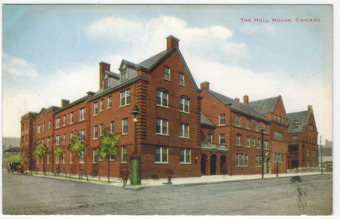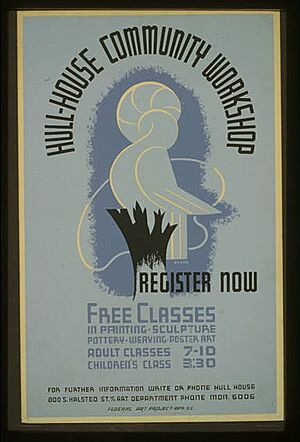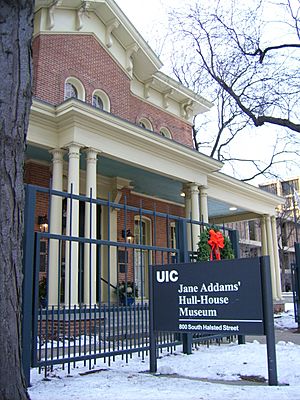Hull House facts for kids
|
Hull House
|
|

Hull House in the early 20th century
|
|
| Location | 800 S. Halsted, Chicago, Illinois, U.S. |
|---|---|
| Area | 1 acre (0.40 ha) |
| Built | building built in 1856, institution founded September 18, 1889 |
| Architect | Pond and Pond |
| Architectural style | Italianate |
| NRHP reference No. | 66000315 |
Quick facts for kids Significant dates |
|
| Added to NRHP | October 15, 1966 |
| Designated NHL | June 23, 1965 |
Hull House was a famous community center in Chicago, Illinois. It was started in 1889 by two women, Jane Addams and Ellen Gates Starr. They wanted to help European immigrants who had recently moved to the city. Hull House was located on the Near West Side of Chicago and was named after its first owner, Charles Jerald Hull.
The center grew quickly. By 1911, it had expanded to 13 buildings. It offered many new and exciting programs in social work, education, and art. Hull House became a model for other community centers, and by 1920, there were about 500 similar "settlement houses" across the United States.
In the 1960s, most of the Hull House buildings were torn down to build the University of Illinois Chicago. However, the original mansion and one other building were saved. Today, these buildings are a museum called the Jane Addams Hull-House Museum. Hull House is recognized as a U.S. National Historic Landmark and a Chicago Landmark because of its important history.
Contents
What Was a Settlement House?
A settlement house was a place in a poor, working-class neighborhood where volunteers lived and worked. These volunteers, often from universities, aimed to help their neighbors by providing services and fighting for social change. Jane Addams got the idea from Toynbee Hall in London, England.
Addams and Starr opened Hull House on September 18, 1889. At the time, women were seeking more education and new roles in society. Hull House was a place where educated women could use their skills to help others. They were called "residents" and lived at the house.
The main goal of Hull House was to offer social and educational opportunities to working-class people. The residents taught classes in subjects like literature, history, art, and sewing. They also held free concerts, lectures on important topics, and ran clubs for both children and adults.
Research and Reform
Jane Addams believed in what she called the "three R's" for settlement houses: residence, research, and reform.
- Residence: Living in the neighborhood to understand its people and problems.
- Research: Studying the causes of poverty and other issues.
- Reform: Pushing for new laws and changes to help people.
The residents of Hull House carefully studied their neighborhood. They used this information to work with city leaders to create programs that would help immigrant families succeed. They even created detailed maps showing where different immigrant groups lived, which was a new and important way to study a community.
The Hull House Neighborhood
When Hull House opened, its neighborhood was home to many different ethnic groups from Europe. An early invitation to a community event was written in Italian, showing that many of the first neighbors were from Italy.
Hull House welcomed everyone, no matter their race, language, or religion. The neighborhood was a mix of people, including Germans, Greeks, and Irish immigrants. Over time, many groups moved to other parts of the city, but the Italian-American community remained strong in the area, which became known as Little Italy.
To help immigrants feel less lonely for their home countries, Addams hosted special ethnic nights. These events featured food, dancing, and music from different cultures, like Italy, Greece, and Germany. These celebrations helped build a strong sense of community.
Major Accomplishments
The women of Hull House did much more than just teach classes. They acted as nurses, helped deliver babies, and provided a safe place for people in trouble. They worked to solve the real-life problems they saw every day.
Their work led to many important changes. At the neighborhood level, Hull House created:
- The first public playground in Chicago (1893).
- A public bathhouse and gymnasium.
- A kindergarten for children whose mothers worked.
Their efforts also led to bigger changes in the law. They helped create the first juvenile court in the United States, which handles cases involving young people. They also fought for:
- Laws to protect children from dangerous jobs (child labor).
- Safer working conditions in factories.
- Laws requiring children to go to school.
- The right for women to vote (women's suffrage).
The work at Hull House inspired social reforms across the country. It showed that by working together, people could make cities a better and fairer place to live for everyone.
Life at Hull House
Hull House offered many services to help with the effects of poverty. A public kitchen provided healthy food for the sick, and there was a daycare center for children. It also offered practical classes, like bookbinding, which helped people find jobs in the printing industry.
The Hull House theater group was very popular. It was one of the first "little theaters" in America. The group performed plays by famous writers like Henrik Ibsen and George Bernard Shaw. Neighborhood residents, including Greek immigrants, would perform classic plays in their own language. This gave the community a chance to celebrate their culture and enjoy the arts.
The official goal of Hull House was "To provide a center for a higher civic and social life; to institute and maintain educational and philanthropic enterprises, and to investigate and improve the conditions in the industrial districts of Chicago."
The Building and Museum
The original Hull House was a large brick mansion built in 1856 by Charles Hull. When Jane Addams found it in 1889, the once-fashionable neighborhood had become crowded and poor due to the large number of new immigrants.
Charles Hull's cousin, Helen Culver, gave the house to Jane Addams to use for free. Over the years, Addams and her team added many more buildings. In the 1960s, the University of Illinois bought the land. Most of the buildings were removed, but the original mansion and the dining hall were saved.
Today, these two buildings make up the Jane Addams Hull-House Museum. The museum is part of the University of Illinois Chicago and is open to the public. It serves as a memorial to Jane Addams and the other reformers who worked to help their neighbors and change the world.
Ghost Stories at Hull House
From the beginning, people said the attic of Hull House was haunted. Over the years, many ghost stories have been told about the building. Some people believed the ghost of Charles Hull's wife, who died in the house, still lived there.
The most famous story was about a "Devil Baby." According to the legend, a baby was born with strange features and was brought to Hull House. Jane Addams was said to have locked the baby in the attic. Addams said the story was not true, but she was fascinated by how much people in the neighborhood believed it.
Addams herself spoke about seeing a "woman in white" ghost in one of the front bedrooms. She seemed more amused by the idea of a ghost than scared. These stories have made Hull House a popular spot for ghost tours in Chicago.
Hull House Today
Jane Addams led Hull House until her death in 1935. The Hull House Association continued to provide social services all over Chicago for many decades. It became one of the city's largest nonprofit organizations, helping about 60,000 people each year.
However, the association faced financial problems. In January 2012, after nearly 122 years of service, the Jane Addams Hull House Association closed down.
The Jane Addams Hull-House Museum, which is separate from the association, remains open. It is part of the University of Illinois Chicago. The museum continues to share the story of Hull House and its amazing residents. It connects their historic work to today's social issues, inspiring a new generation of reformers.
See also
 In Spanish: Hull House para niños
In Spanish: Hull House para niños









